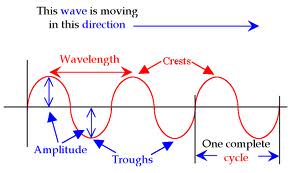TRANSVERSAL WAVES
A transverse wave is a moving wave that consists of oscillations
occurring that are perpendicular(at right angles) to the direction of
energy transfer. Examples of transverse waves include seismic S waves
and the motion electric and magnetic fields in an electromagnetic plane
wave, both of which oscillate perpendicularly to each other as well as
to the direction of energy transfer.
An S-wave(secondary wave, or shear wave) is one of the two main types
of elastic body waves. These waves move through the body of an object.
The S-wave move as a transverse wave. The wave moves through elastic
media, and the main restoring force comes from shear effects. These
waves are lack divergence and obey the continuity equation for
incompressible media. They are the second direct arrival on an
earthquake seismogram, coming after the compressional primary wave(p
wave) because S-waves travel slower. An S-wave cannot travel through the
molten outer
core of the Earth,
and cause a shadow zone for S-waves opposite to where they originate.
They appear in the solid inner core. When a P-wave strikes the boundary
of molten and solid cores(Lehmann discontinuity), S-waves will then
propagate in the solid medium. And when the S-waves hit the boundary
again they will in turn create P-waves. This is used by scientists to
study the inner core.
Transverse waves actually produce the majority of the information
that we have about the inner core. The rest is equal parts theory and
speculation.

The
waves are the movement of a distortion of a material or medium, where
the individual parts or elements of the material only move
back-and-forth, up-and-down, or in a cyclical pattern. The waves
requiring a medium are called
Mechanical Waves and those which do not require a medium are called
Non Mechanical Waves.
Methods of energy propagation in which disturbance propagates with definite velocity without changing its form, is called Mechanical Wave. Energy and momentum propagates by motion of particles of medium. But medium remain at previous position, mass transfer does not take place. Propagation is possible due to property of medium viz. elasticity and inertia. The mechanical waves are basically of two types-
Transverse waves
TRANSVERSE WAVES
To explain transverse waves, we will again use our example of water waves. Figure 1-3 is a cross
section diagram of waves viewed from the side. Notice that the waves are a succession of crests and
troughs. The wavelength (one 360 degree cycle) is the distance from the crest of one wave to the crest of
the next, or between any two similar points on adjacent waves. The amplitude of a transverse wave is half
the distance measured vertically from the crest to the trough. Water waves are known as transverse waves
because the motion of the water is up and down, or at right angles to the direction in which the waves are
traveling. You can see this by observing a cork bobbing up and down on water as the waves pass by; the
cork moves very little in a sideways direction. In figure 1-4, the small arrows show the up-and-down
direction the cork moves as the transverse wave is set in motion. The direction the wave travels is shown
by the large arrow. Radio waves, light waves, and heat waves are examples of transverse waves.

